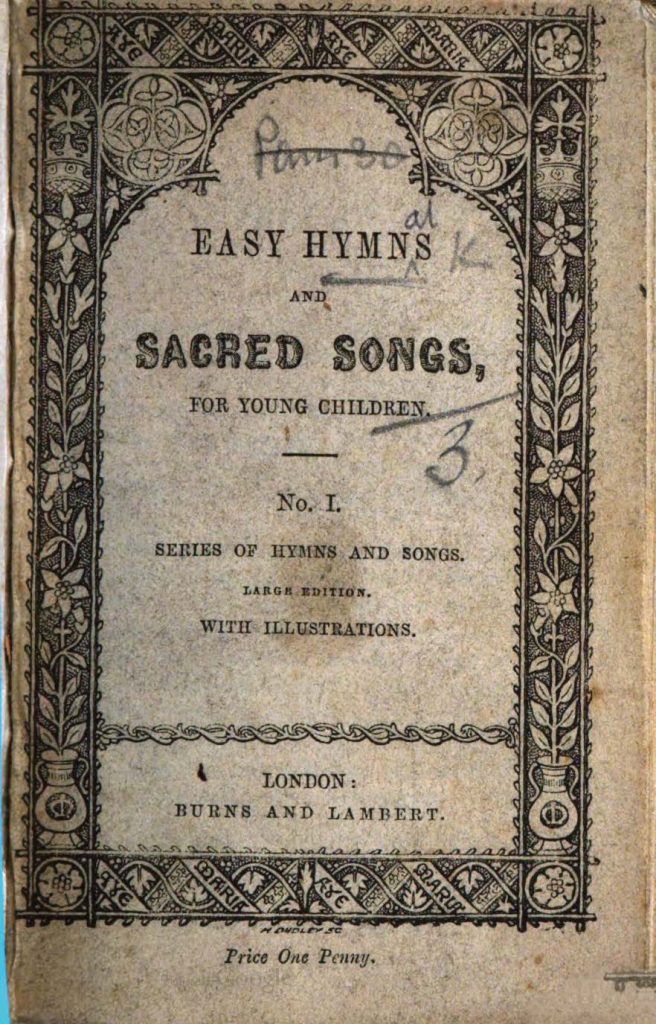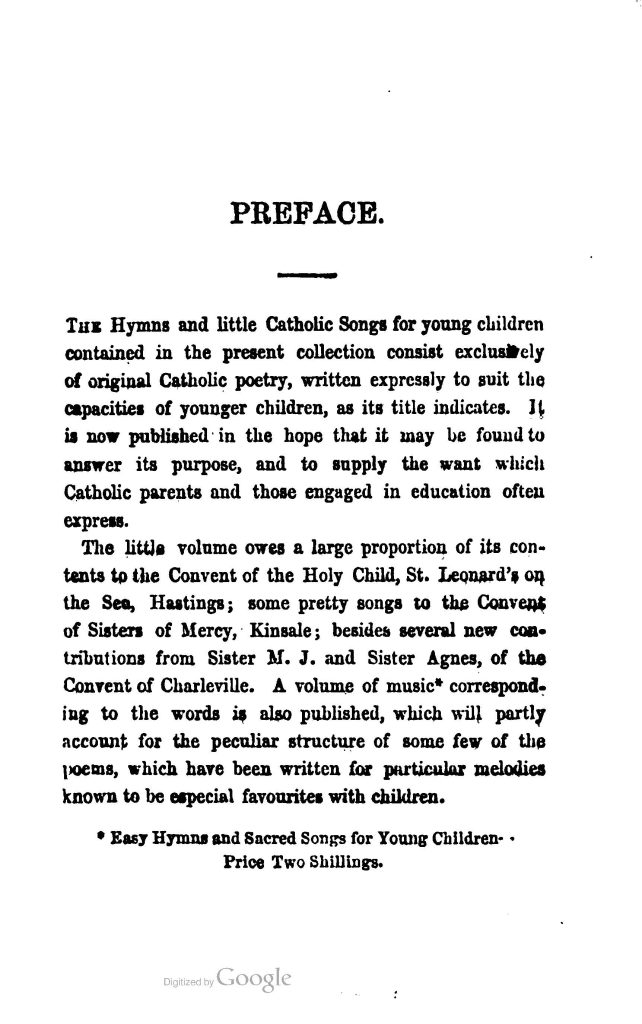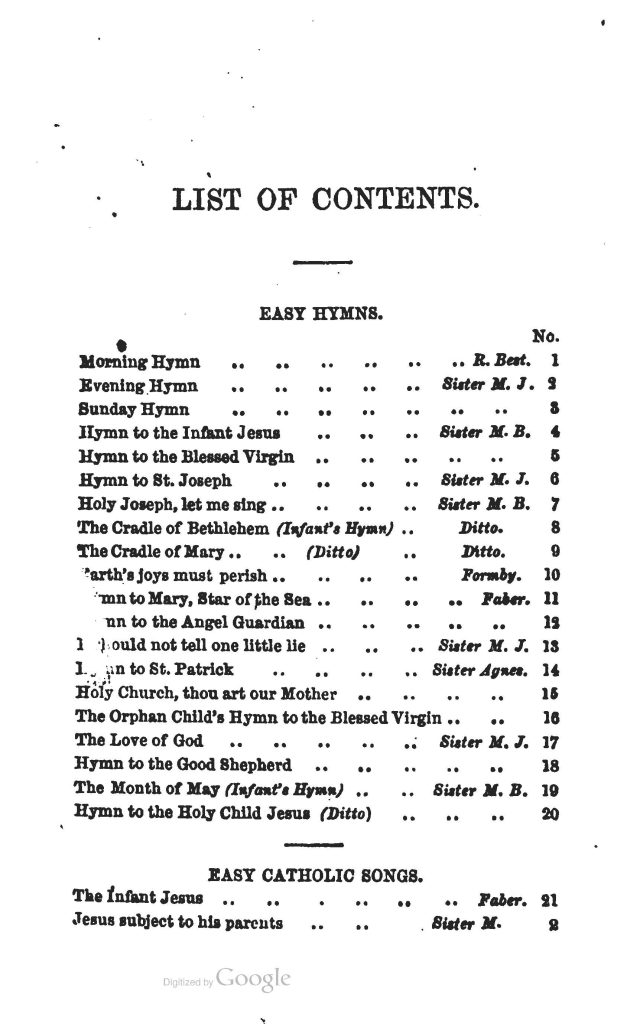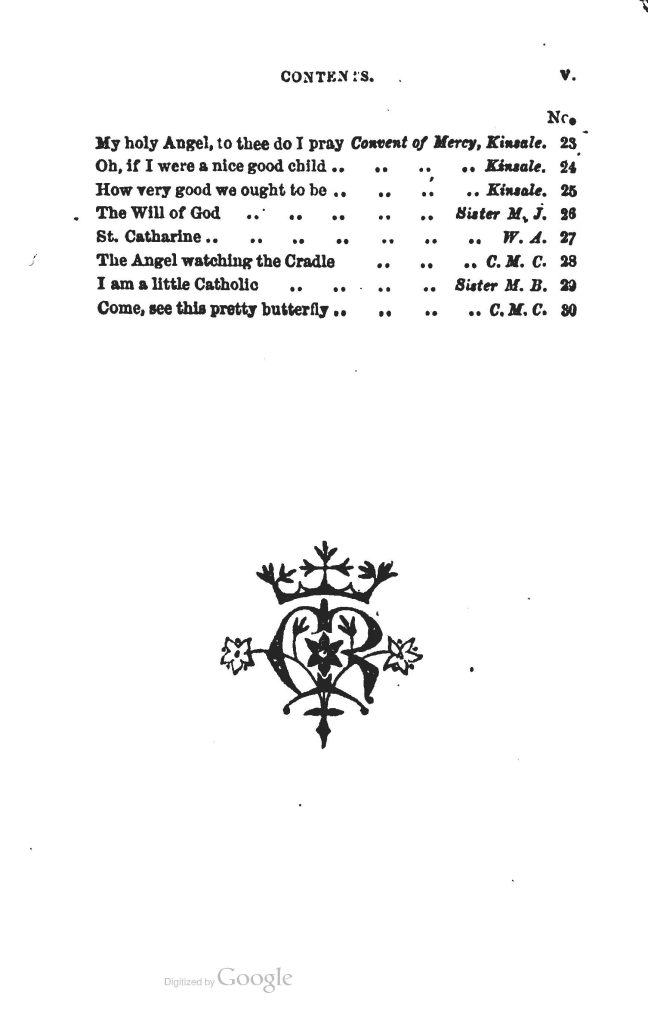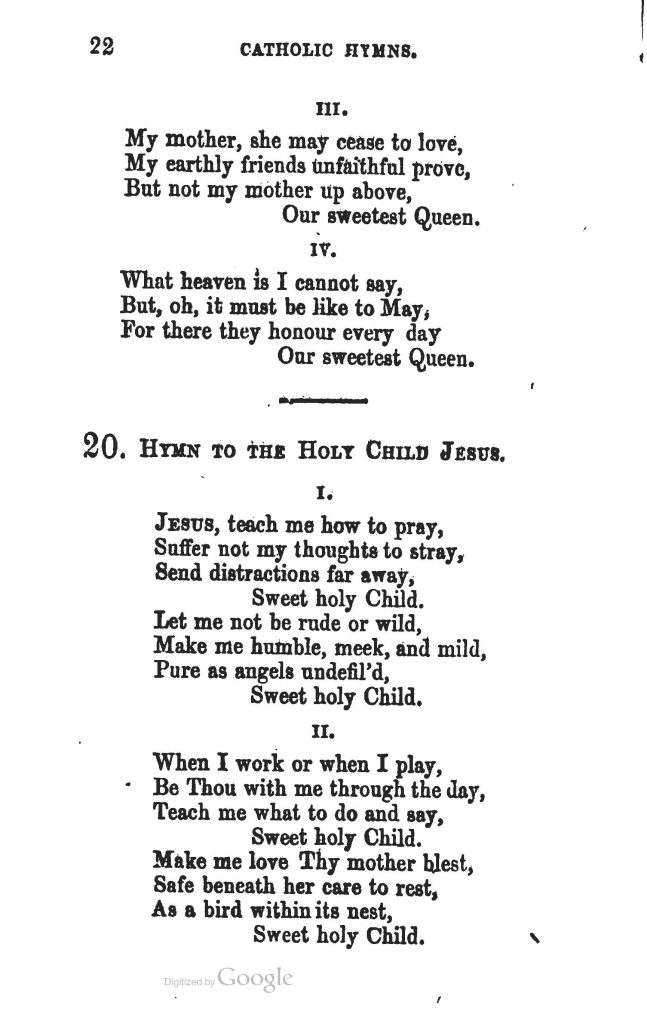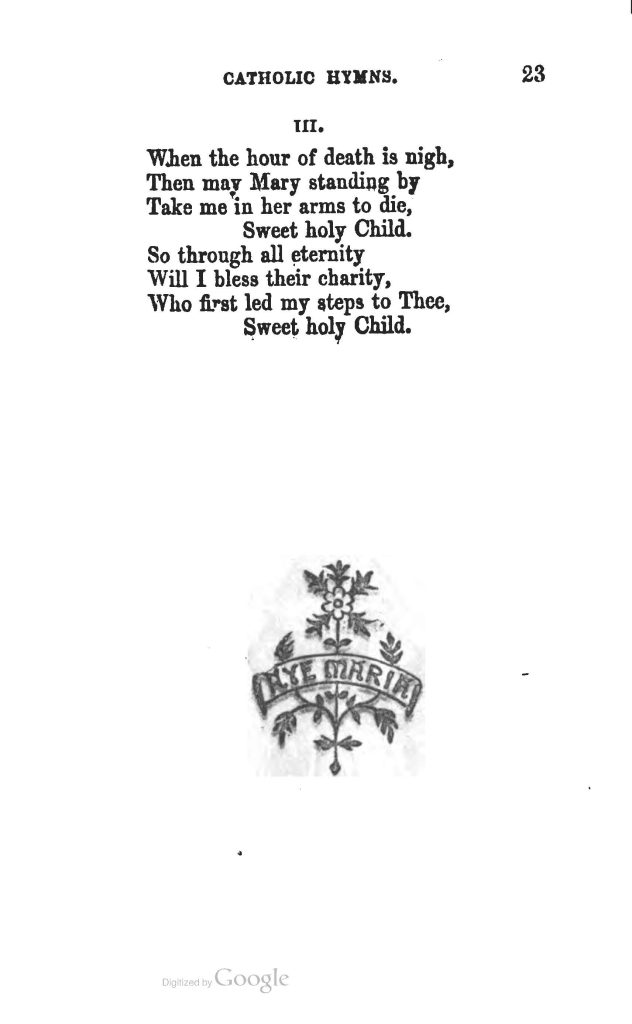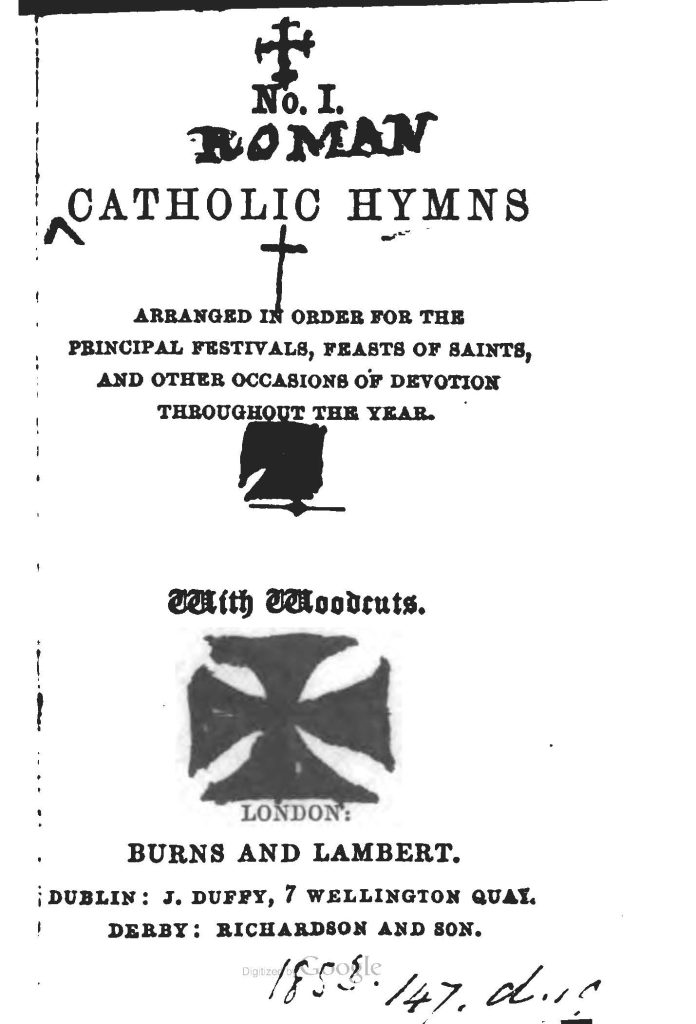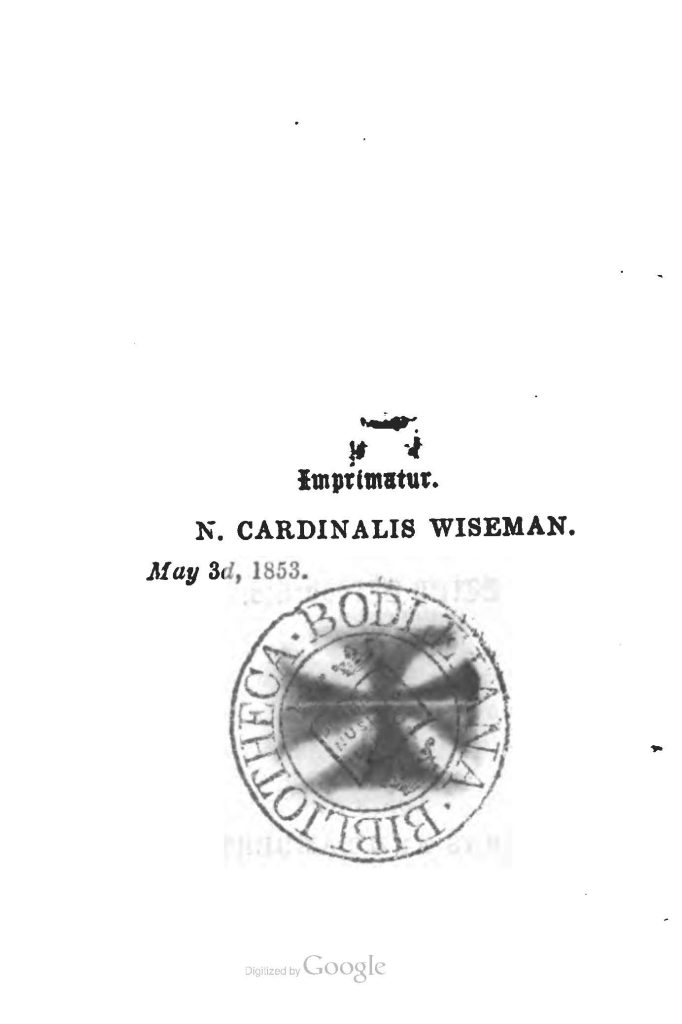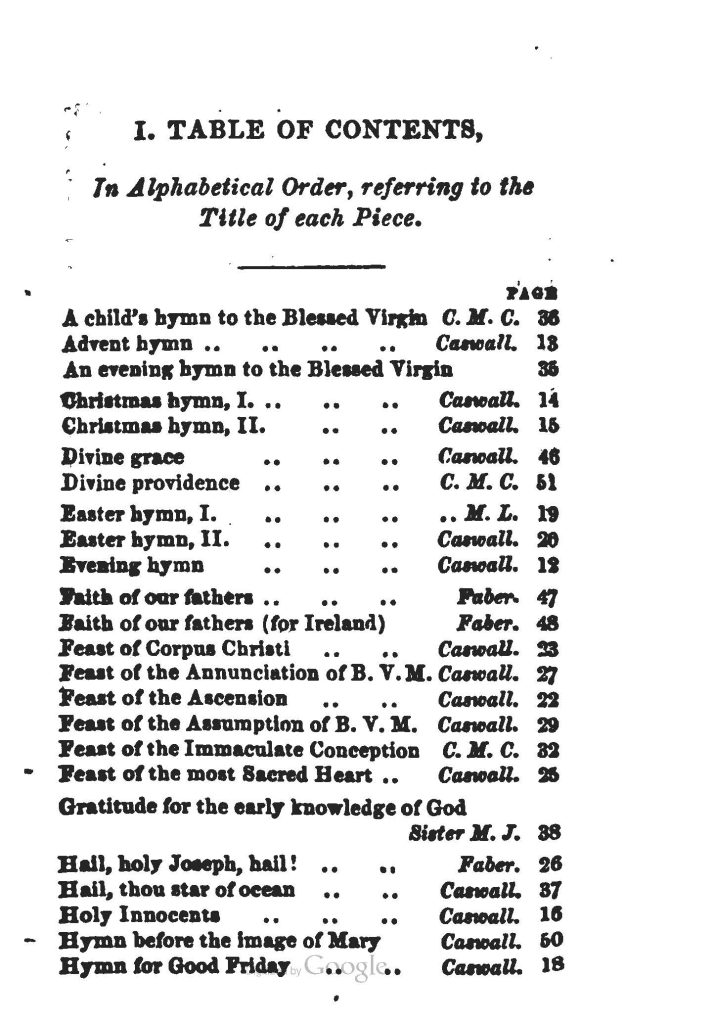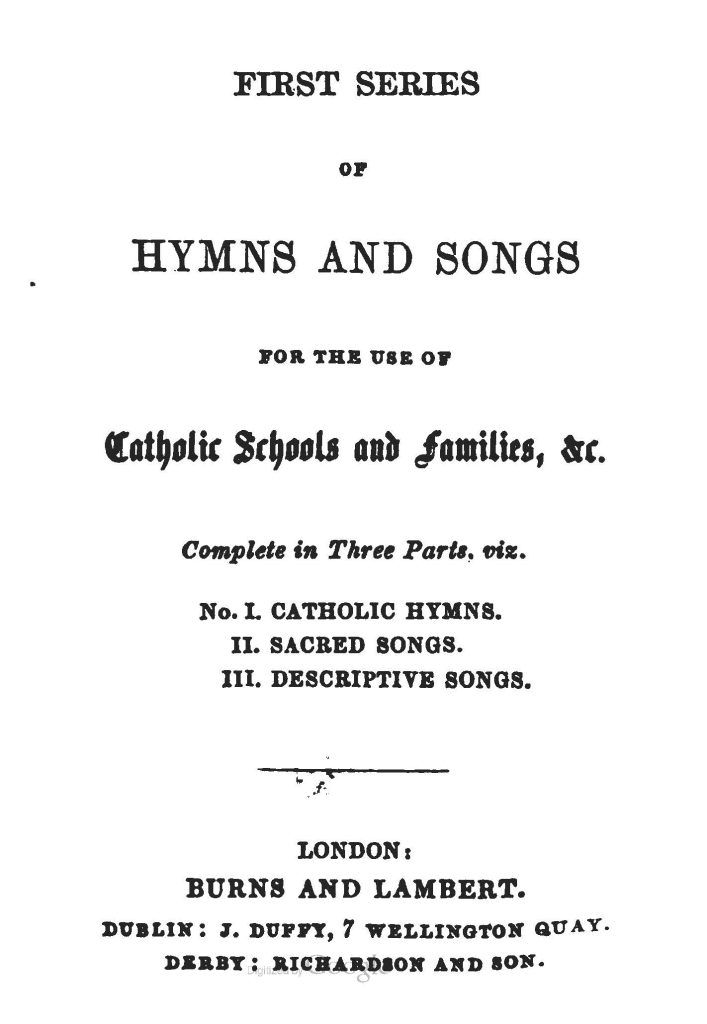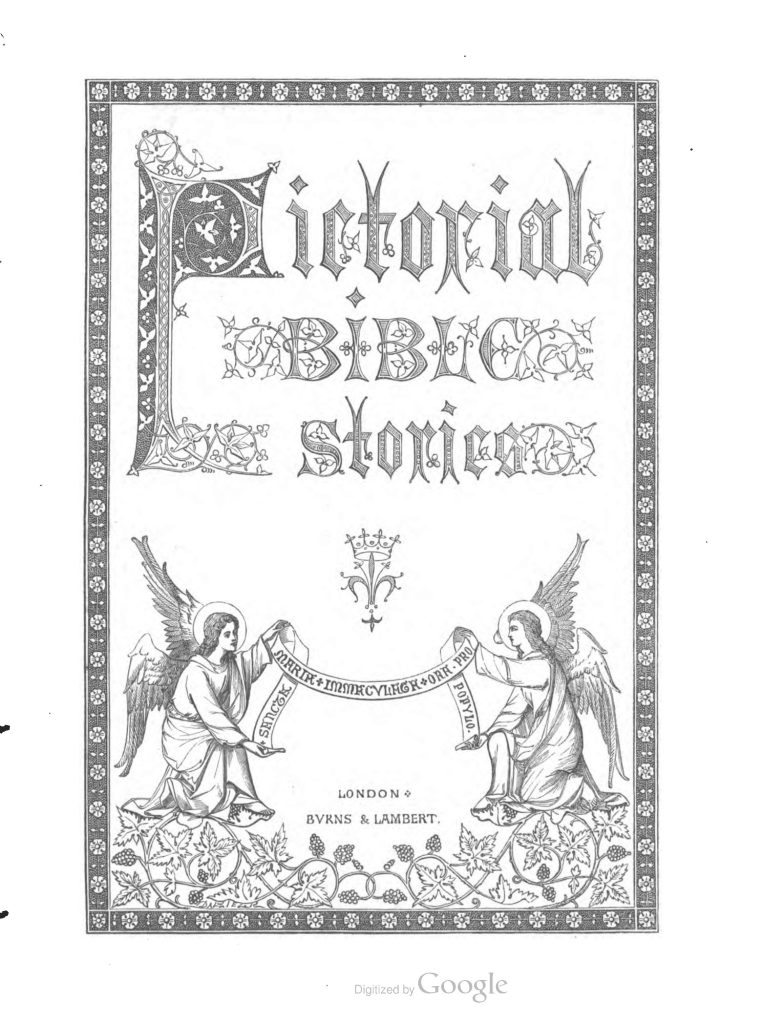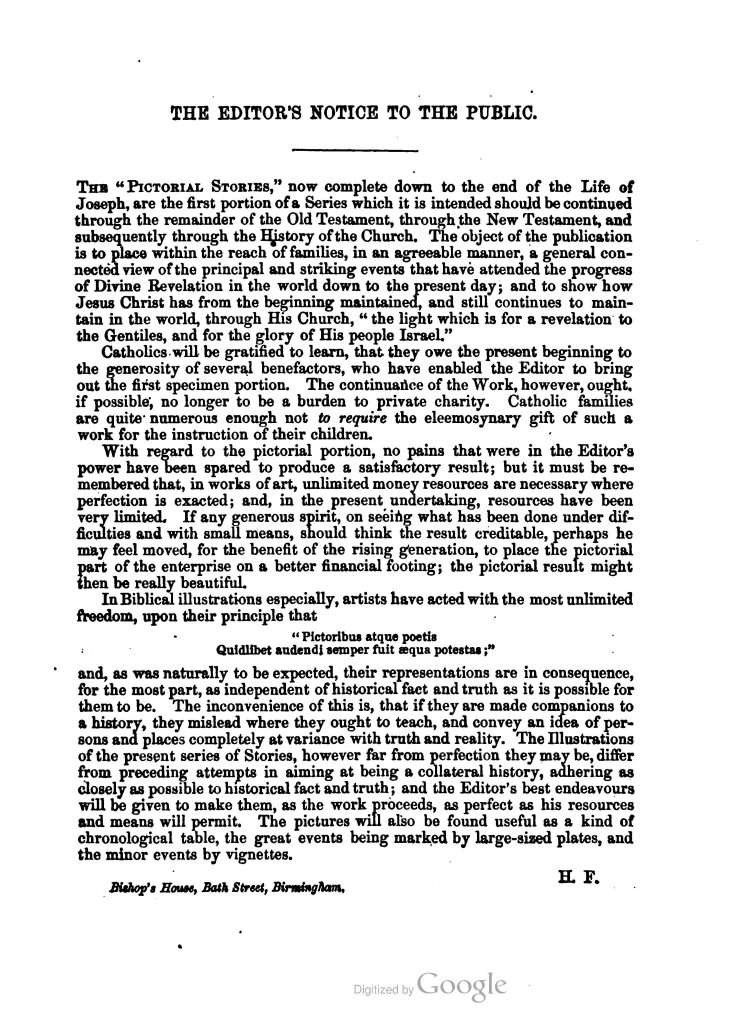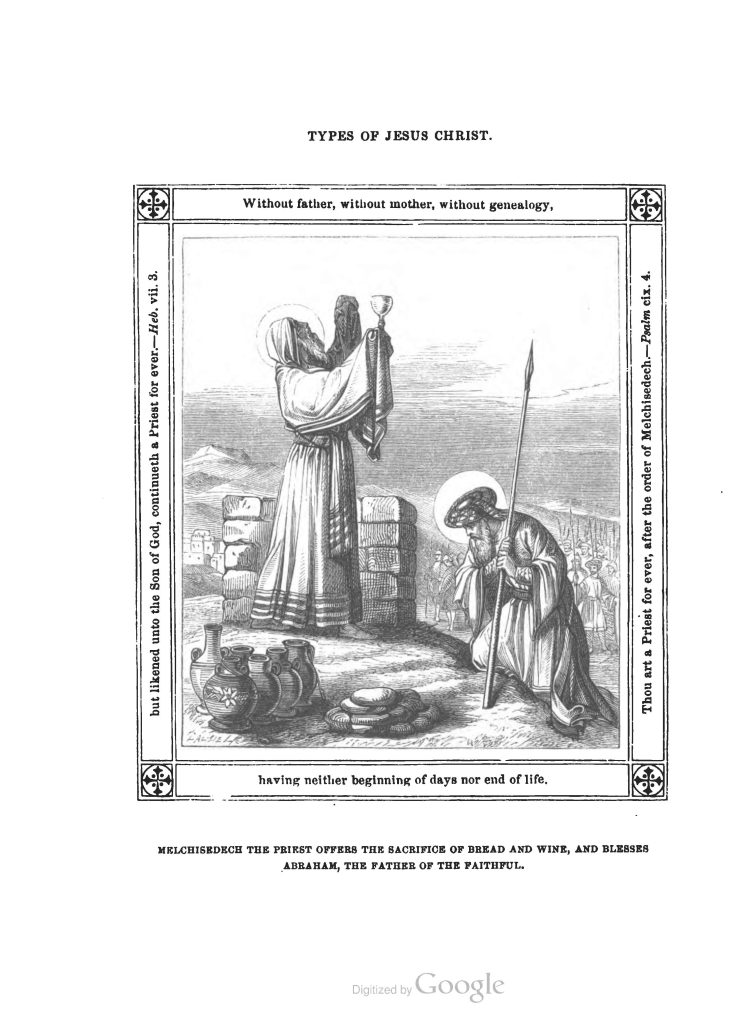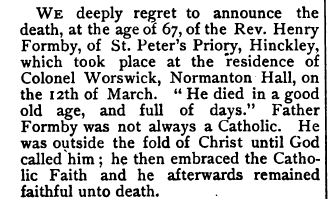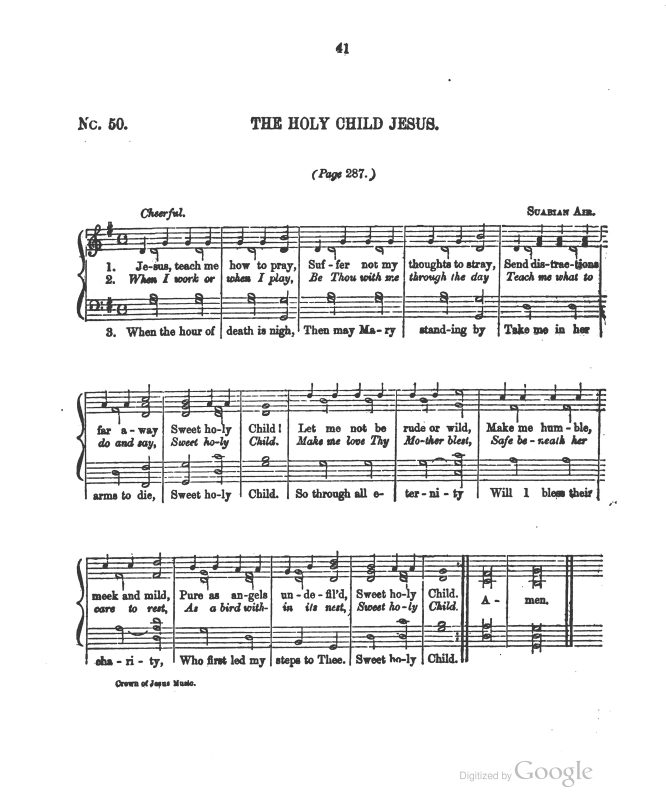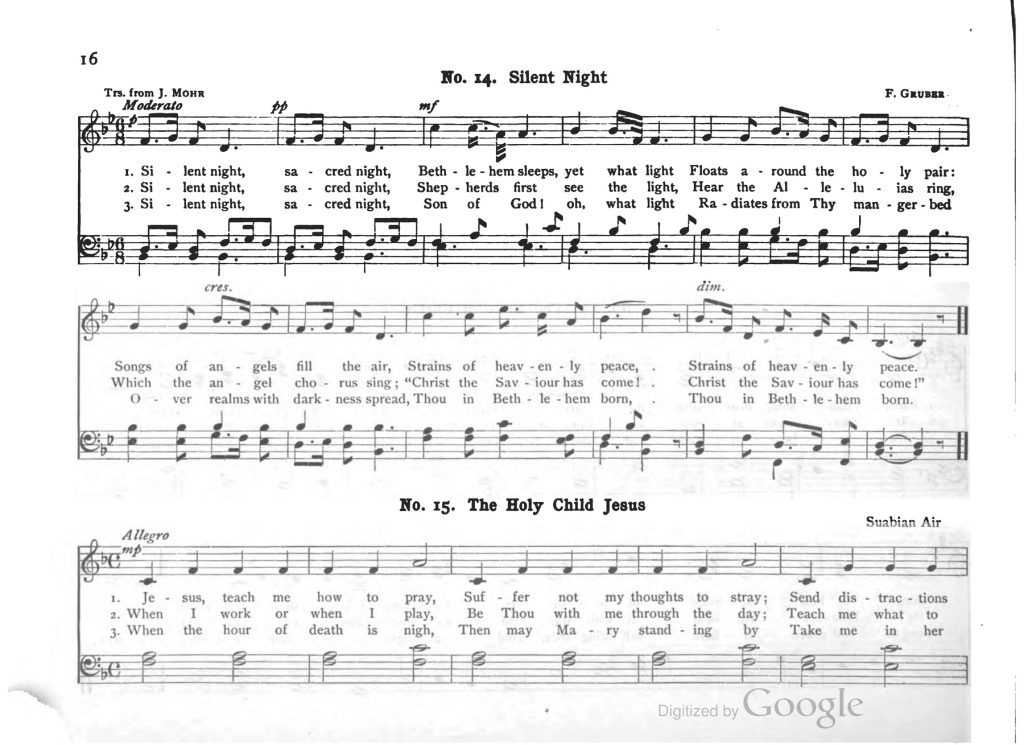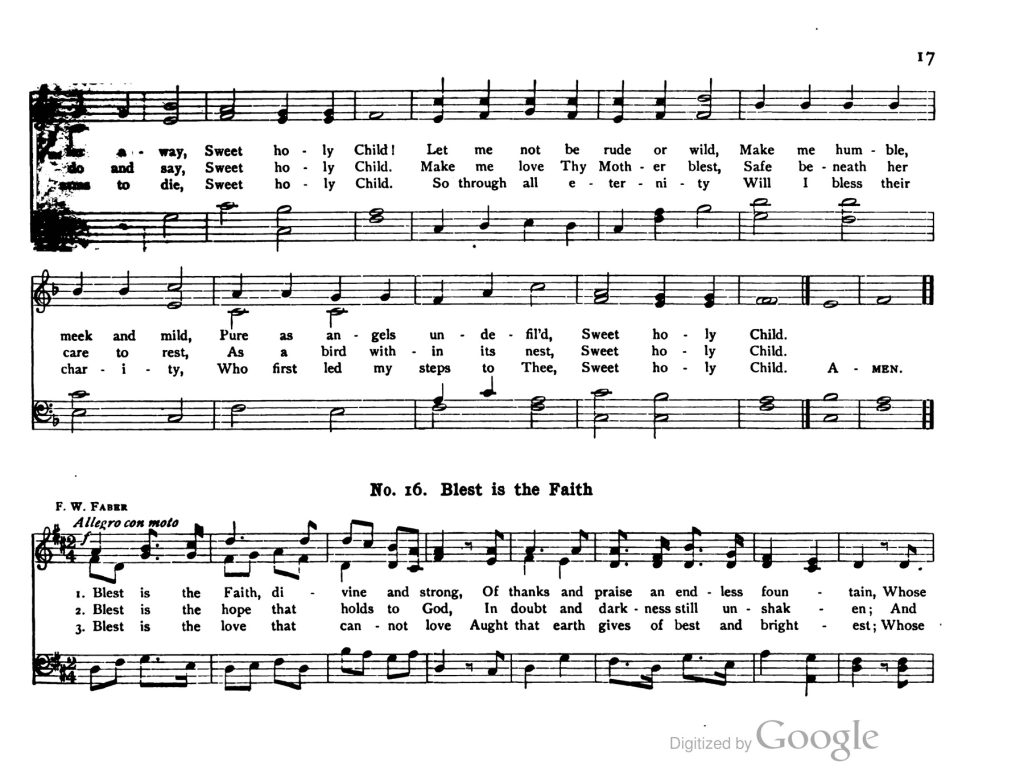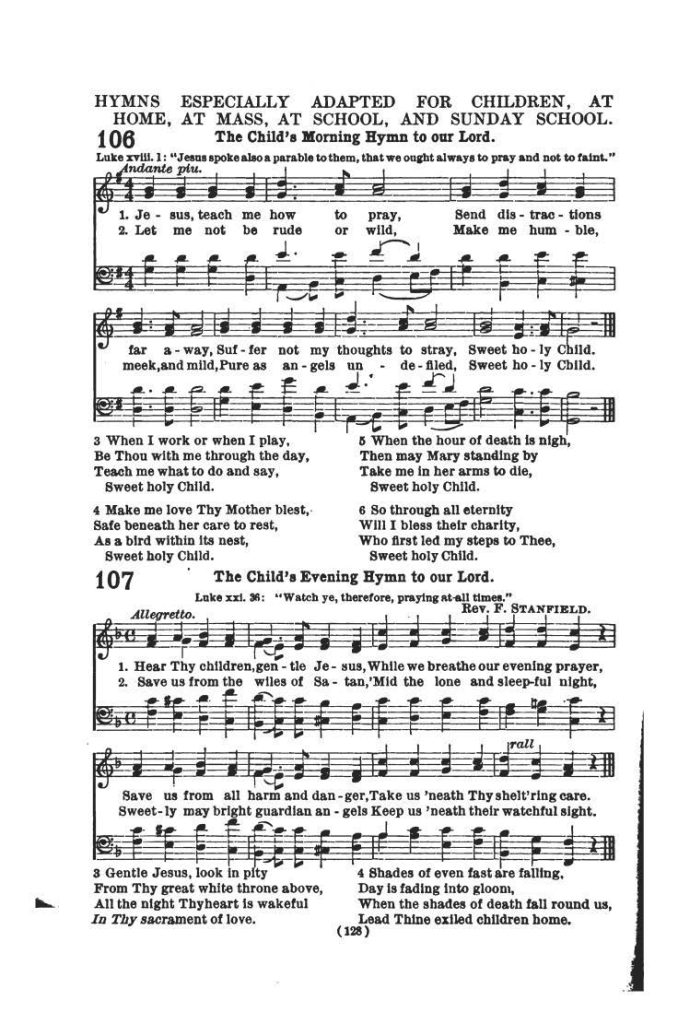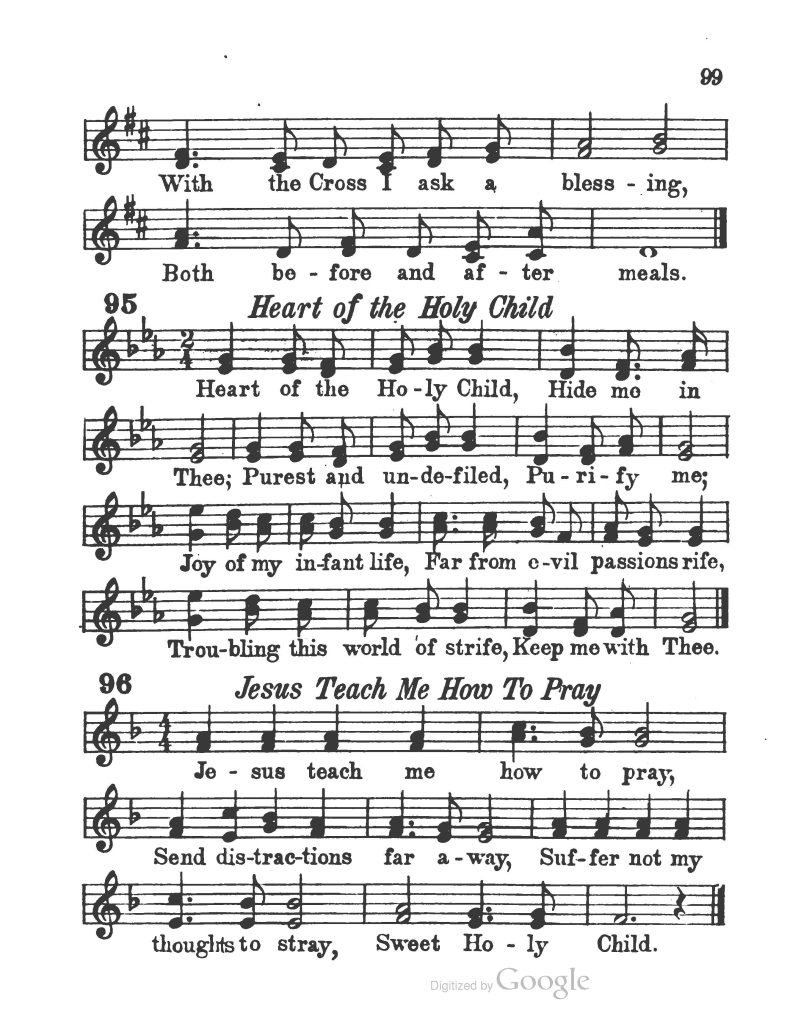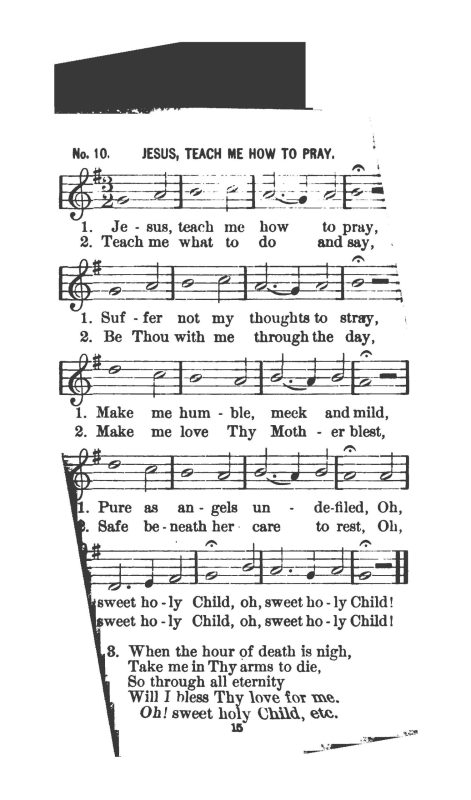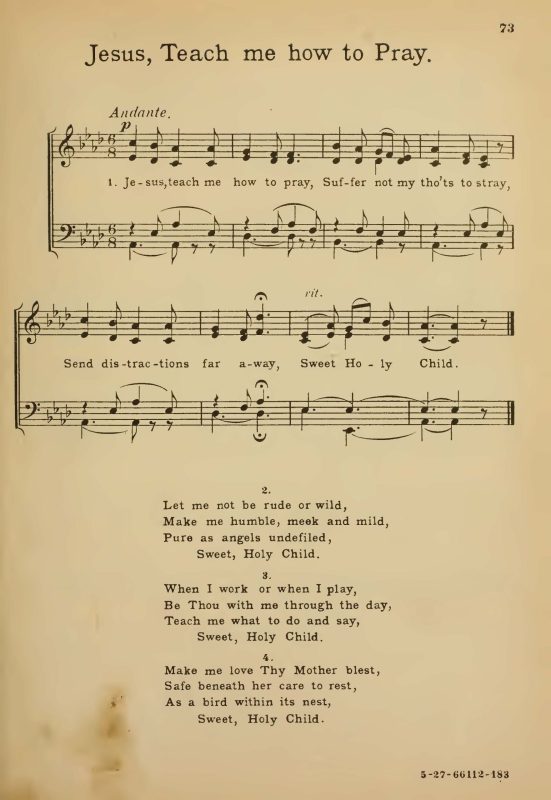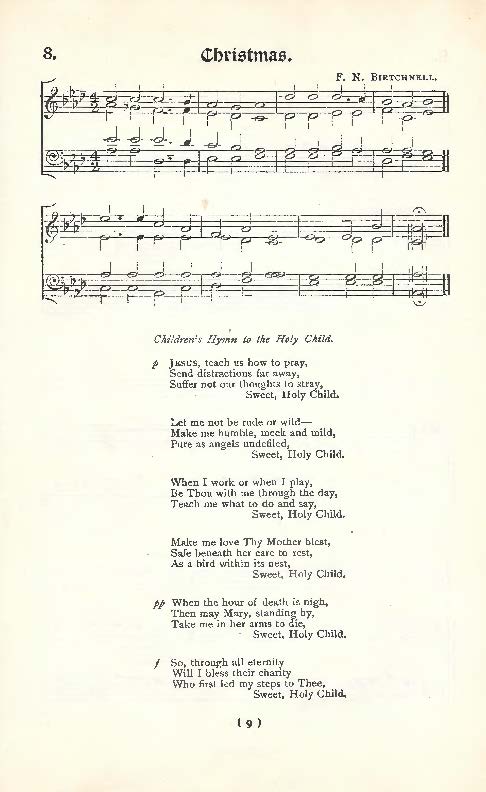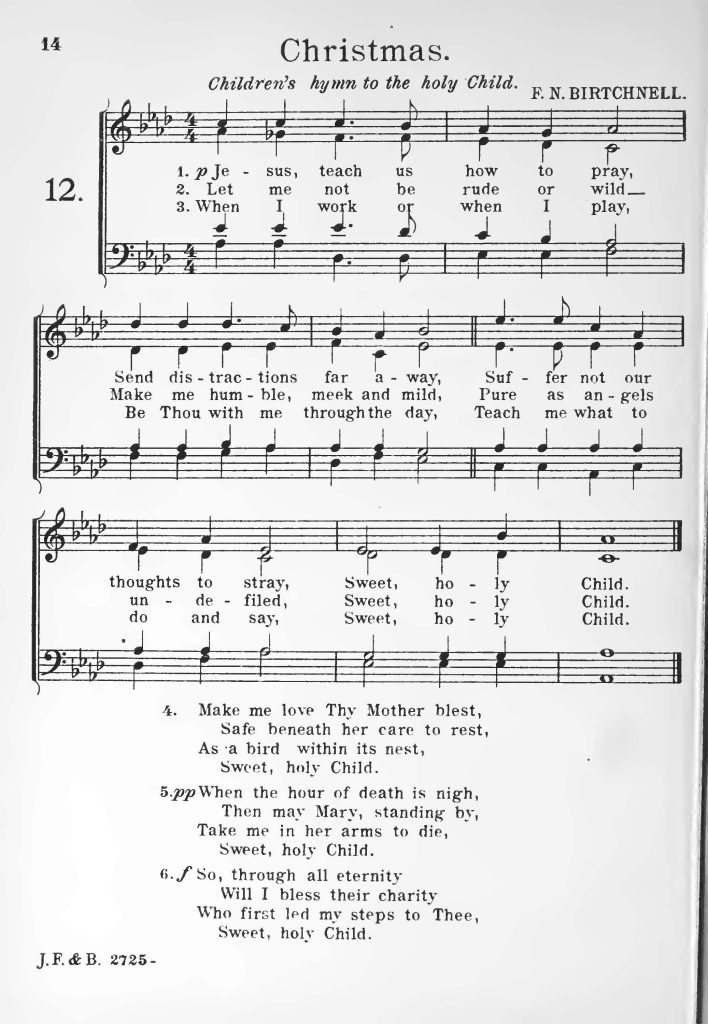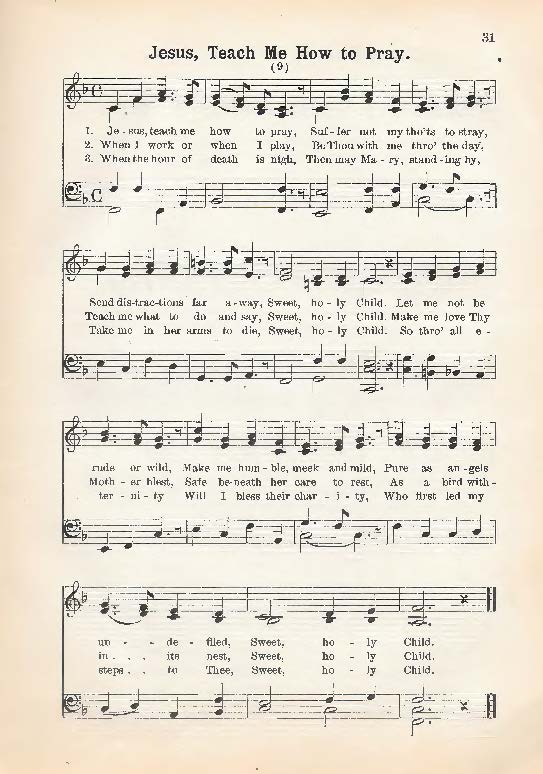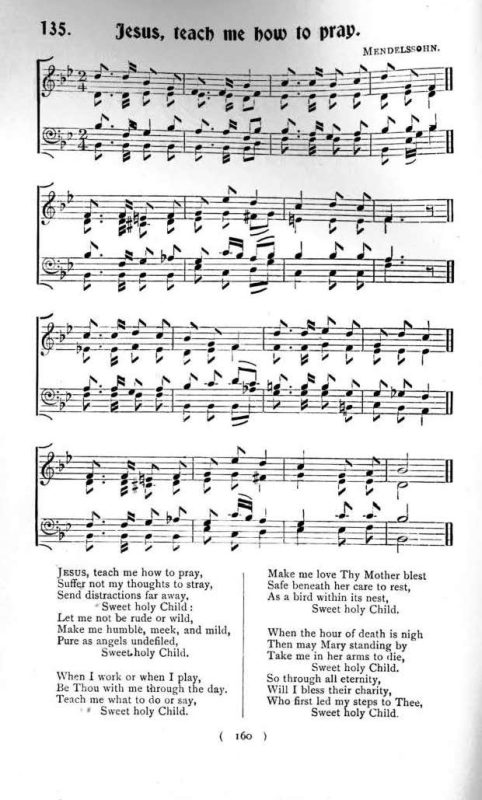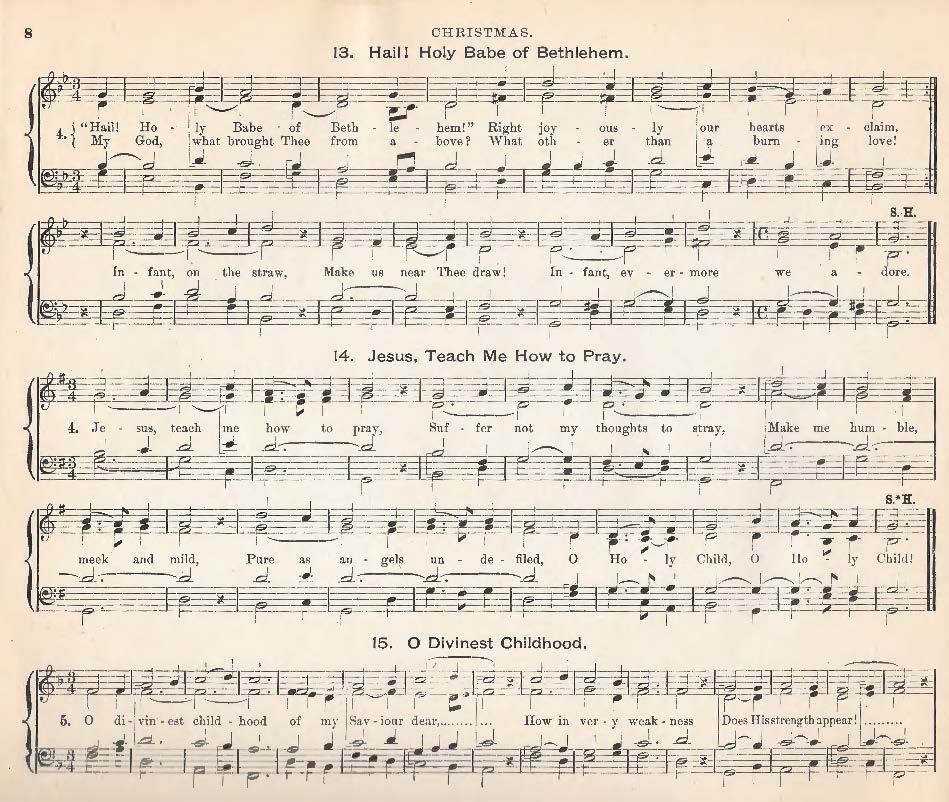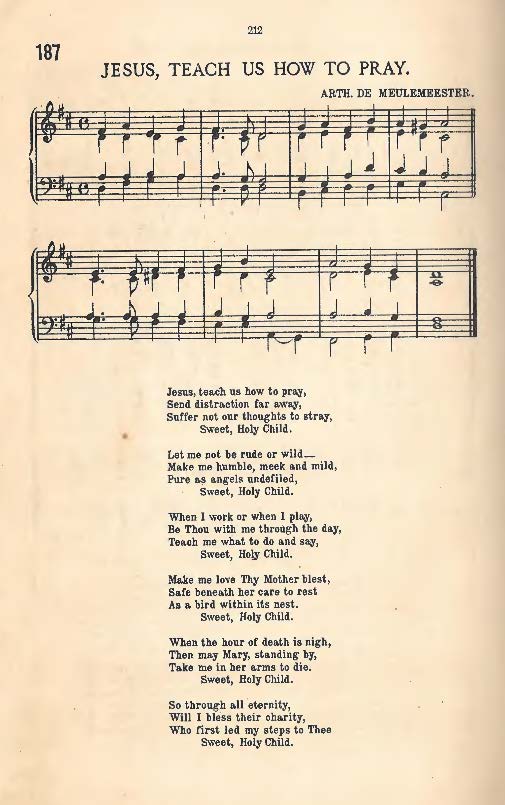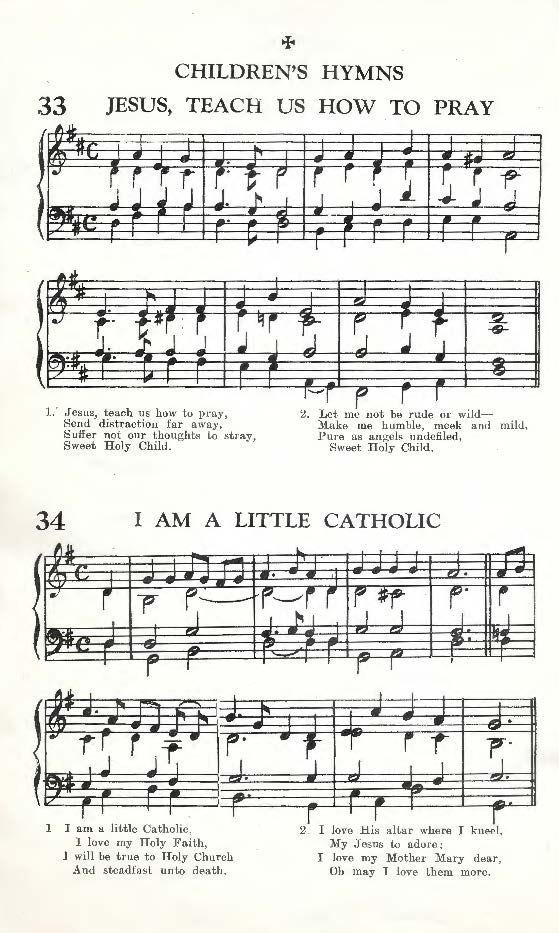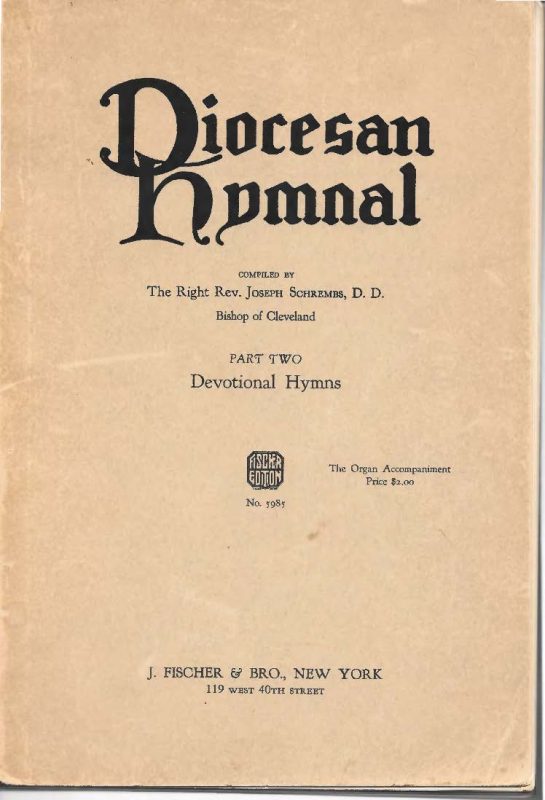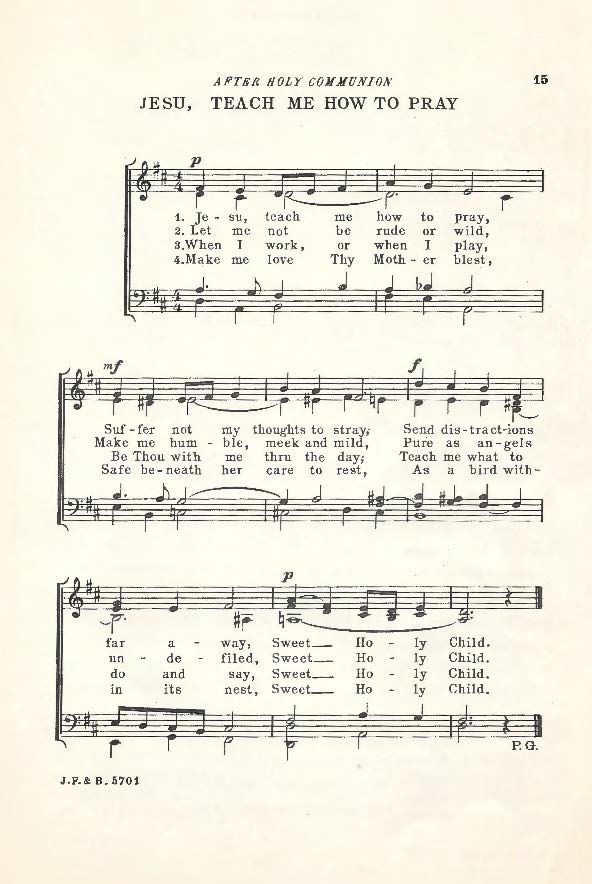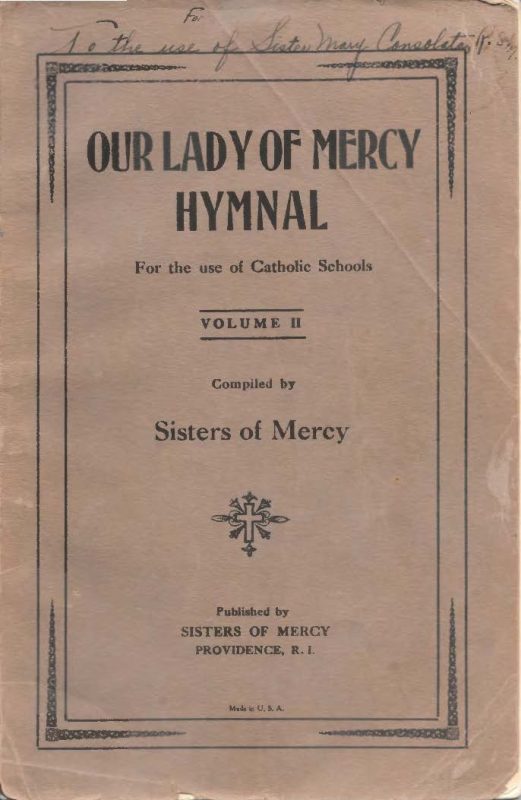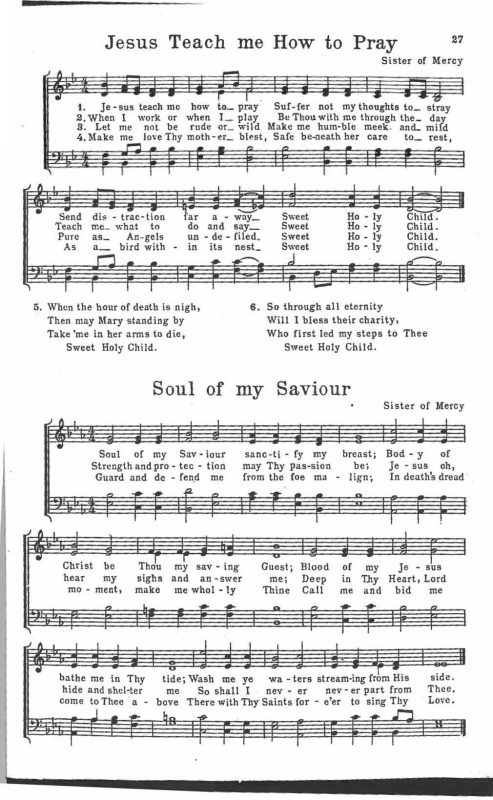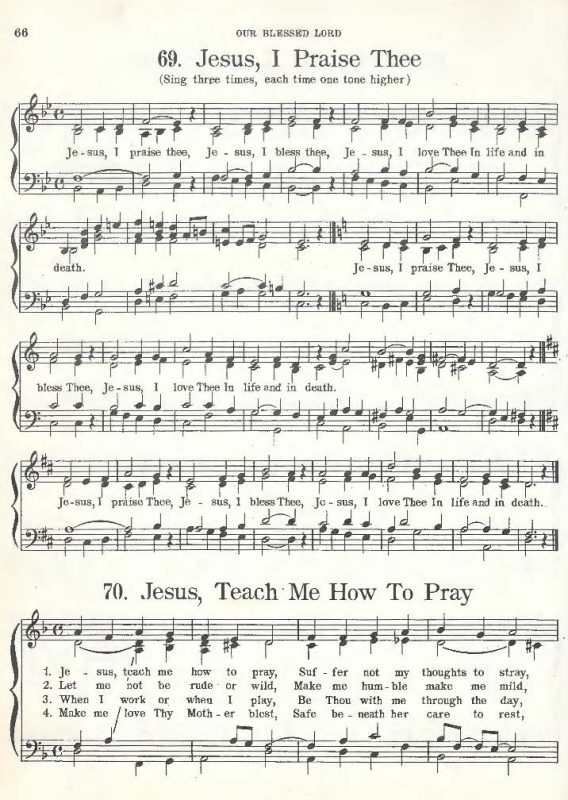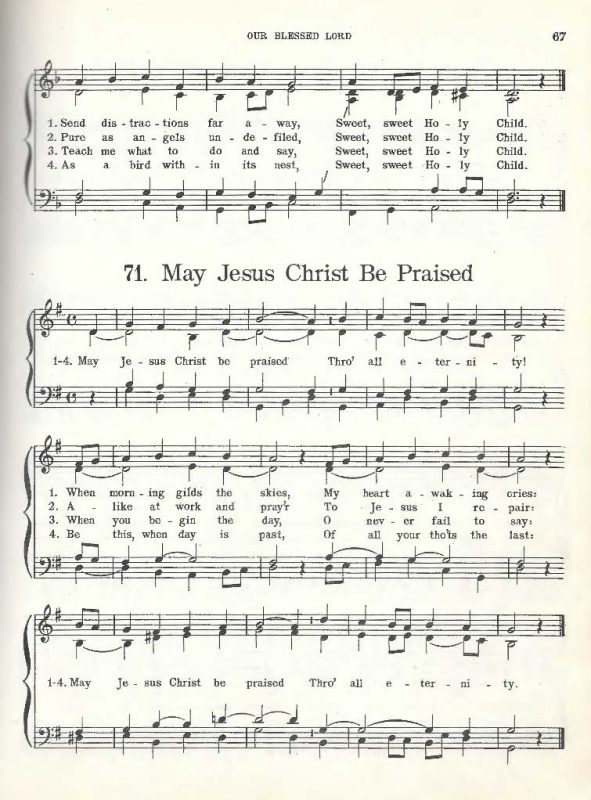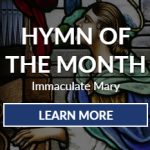The words of this hymn were written by a Sister of Mercy from the Convent of Charleville, County Cork, Ireland. We know her only as Sister M. B. Her hymn first appeared in EASY HYMNS AND SONGS compiled by Father Henry Formby and published by Burns and Lambert of London in 1853. A musical edition of this collection was also published, and one would be extremely fortunate to have a copy. The melody found in the musical edition is a Suabian Air. (Click on any image to enlarge)
Information provided by the archivist of the Charleville convent indicates there were two sisters from that period that might be the author. From the Charleville Community there is Sister Mary Baptist Keating (1823-1863). Catherine Keating was born in Cahir, County Tipperary in Ireland to her parents Patrick and Cathrine in 1823. She entered the convent on September 26, 1855 and was professed April 13, 1858. From the annals of the Charleville convent provided by the archivist we are given the following account:
Sister Mary Baptist Keating was remarkable for many virtues, but for two in particular, to a degree uncommon even in religious communities. These were confidence in God and charity. She seemed never to waver in a steady faith that she would go to heaven when she died and straight. No lecture from the most ascetic writer, no meditation on the purgative way from the keenest Jesuit that ever addressed us in retreat, were able to shake for an instant that deep-rooted confidence or to throw one shade of fear over her face. Her charity was equally remarkable, no matter who was accused, saint or sinner in much or in little. Sr. M. Baptist always had their excuse ready, and we fancied that her features had a look of pain until politeness allowed her to reply and offer her excuse and this was generally so natural and simple that one felt quite satisfied with it.
The circumstances of her last moments were also remarkable. About an hour or two before she died, she called Rev. Mother to her and desired her to put her arm under her head that she might feel she was there for her and that she might die soon. Rev. Mother did so and whispered, Have you the same confidence in your good God that you always had? O, the very same, she said, the greatest confidence. In a little while after we thought she was dying and put the candle in her hand and knelt. After a while she opened her eyes and said, smiling, I thought too I was dying but I won’t for a little while – the moment I see God I’ll die. She allowed Rev. Mother to withdraw her arm but soon motioned her to post again and, Rev. Mother remembers she said, Stay there. I will surely die now. My Jesus… She stretched her feet, closed her mouth and eyes, and died. Sister Mary Baptist Keating died on March 25, 1863 and is buried at the Convent Cemetery in Charleville.
Another likely candidate is Sister Mary Francis Bridgeman (1813-1888), she was a pioneer of the Sisters of Mercy in the Crimea who made many foundations in Ireland and abroad and was forever writing, she is from the Kinsale Community. From the annals of the Kinsale convent we are given the following account:
She began her nursing experience at a Limerick cholera hospital during the 1832 epidemic, and by 1854, she had considerable experience caring for the sick and the poor. She kept an account of her experiences, recording the conditions under which they travelled to the Crimea, the state of the hospitals they worked in, their relationships with the soldiers, medical and military authorities.
All of the sisters mentioned above were acquainted with one another from their time during the Crimean War (1853-1856), as all of them were nurses. The Sisters of Mercy achieved great success as nurses and were recognized by the military commanders for their compassion toward the wounded and their cleanliness of the hospitals during the war effort. Sister Frances Bridgeman, later Mother Francis Bridgeman would work closely with another famous nurse of the Crimean War, Florence Nightingale.
Some of Sister M. B.’s poems became Catholic hymns. Nearly all of them are for children including a Christmas hymn – Heart of the Holy Child, and I Am a Little Catholic, this last hymn would later become, I Am a Faithful Catholic with music attributed to Mozart. She also authored the popular Christmas hymn Oh! Sing a Joyous Carol, which is still being sung today. For now the true identity of Sister M.B. must remain a mystery.
On an aside, another Sister of Mercy from the Charleville Convent who is listed in the index of the hymn book above is Sister M. J. She has been identified as Sister Mary Joseph Croke (née Isabella Croke). She was born in Mallow, County Cork, Ireland in 1825. She was also a nurse during the Crimean War (1854-1856) and kept a journal during the war with entries amounting to over 160 pages. Isabella was a convert to Catholicism and entered the Sisters of Mercy on August 15, 1847, was received on February 22, 1848, and made her vows on April 10, 1850. She wrote poetry, and several became hymns and appeared in Father Formby’s collection of hymns, HYMNS FOR THE YEAR published in 1867, and Westlake’s POPULAR HYMN AND TUNE BOOK published in 1868.
This short narrative on Sister Mary Joseph Croke is taken from the article Sister Mary Joseph Croke – Another Voice from the Crimean War by Mary Ellen Doona.
You might also notice in the index a hymn to St. Patrick by Sister Agnes. The hymn would later become known as Hail, Glorious St. Patrick written by Sister Mary Agnes McSweeny after Ireland had been ravaged by a famine in 1850.
In 1842, Elizabeth (Eliza) McSweeney entered the Convent of Mercy of the Sisters of Mercy in Charleville, Co. Cork, Ireland. She was a member of this community until she left on a mission in the summer of 1866 to Bathurst in Sydney Australia. Sister McSweeney was one of seven nuns to go to Bathurst along with her cousin Sister Mary Ignatius Croke.
The journey to Australia took three months at sea. Sister McSweeney loved teaching First Holy Communion classes, visiting the sick, the poor and the homes of her students as well as visiting the prisoners in the Bathurst jail. She was known for her remarkable abilities and was well versed in French and English literature, church history and skilled in poetry. Sister McSweeney died at the age of 81 in 1905 and is buried at the convent cemetery in Bathurst.
EASY HYMNS AND SACRED SONGS FOR YOUNG CHILDREN was a small sized text collection of Catholic hymns compiled by Father Henry Formby (1816-1884). The following biographical details on Father Henry Formby are taken from the Biographical Dictionary of the English Catholics, Vol. 2. pages 309-313, by Gillow, Joseph, 1850-1921.
Henry Formby was born in 1816, the son of Henry Grenehalgh Formby, second son of Richard Formby, of Formby Hall, Lancaster, Esq. He was educated at Clitheroe Grammar School, and from there to the Charterhouse School, and ultimately was admitted into Brasenose College, Oxford. Brasenose College is a constituent college of Oxford University. He received a Master of Arts and took Orders in the Church of England and was appointed vicar of the Ruardean village in Gloucester.
His parish was quite large, and he petitioned to have the parish divided but his plan was opposed by his bishop. This was during the Tractarian Movement which he followed with keen interest. Greatly influenced by the conversion of his friend John Henry Newman, he chose to resign his position in the Church of England and was received into the Catholic Church, at St. Mary’s College, Oscott, January 24, 1846. He passed his theology studies at Oscott and was ordained a priest by Bishop Wareing (1791-1865) the first Roman Catholic Bishop of the Diocese of Northampton, on September 18, 1847.
For a number of years he served at St. Chads, Birmingham, and at Wednesbury. During the later part of his life, about twenty years, he resided at the Dominican Priory of St. Peter, Hinckley, Leicester where he assisted in preparing the novices for the priesthood.
Father Formby was a prolific writer publishing more than forty volumes of Catholic catechetical material. One such example was a three-part series of Catholic Hymns and Songs for the use of Catholic Schools and Families published in 1853. This collection was sold by Burns & Lambert of London as one volume and carried the Imprimatur of Cardinal Wiseman. Part I of this collection is captioned Catholic Hymns. Part II: Sacred Songs, and Part III: Descriptive Songs. Each part has a list of contents, authors, and index of first lines. At the time of publication many of the authors, including Father Faber, Father Caswall, Cecilia M. Caddell, Sister M. J., and Mary E. Leeson were still living and many of the hymns had never before been published.
In another example, Father Formby published several Bible story books, a series of publications carefully illustrated for use by Catholic families and schools.
Father Formby was the leader in England in producing illustrated catechetical materials for all age groups but most especially the children. He died during a visit to Colonel Worswick who resided at Normanton Hall on March 12, 1884, at the age of sixty-seven. He is buried at St. Joseph’s College, Mill Hill.
The hymn Jesus, Teach Me How to Pray, appeared in a period that produced many hymns for children. Some of Sister M. B.’s hymns found their way into American hymnals including the CATHOLIC CHURCH HYMNAL, 1905 compiled by Augustus Edmonds Tozer; the SUNDAY SCHOOL HYMN BOOK, 1887, 1907 and 1935 compiled by the Sisters of Notre Dame; CROWN HYMNAL, 1913; CLEVELAND DIOCESAN HYMNAL, 1926; OUR LADY OF MERCY HYMNAL, VOL. II, 1927 compiled by the Sisters of Mercy from the Providence, Rhode Island Community and THE ST. FRANCIS PARISH HYMNAL, 1954. A complete list of hymnals can be downloaded clicking on the following link Jesus Teach Me How to Pray – Hymnal Survey
The Melodies
I found twelve different melodies that have been composed for this hymn. Several of the composers and sources have been identified including Frank N. Birtchnell (1860-1941); Felix Mendelssohn (1809-1847); a Suabian Air; a Sister of Mercy; a Sister of Notre Dame de Namur; Arthur De Meulemeester; a melody from Muenster’s 1866 Gesangbuch, and a melody by Bishop Schrembs (1886-1945) of Cleveland, Ohio. There are four melodies that I could not identify. (Click on any image to enlarge)
The first melody to be used for Jesus, Teach Me How To Pray, is identified as a Suabian Air. It is found in the musical edition of EASY HYMNS AND SACRED SONGS FOR YOUNG CHILDREN compiled by Father Henry Formby in 1853. It also appears in the CROWN OF JESUS MUSIC compiled by Henry F. Hemy (1818-1888) and published by Thomas Richardson & Sons of London in 1864, and the CROWN HYMNAL, compiled by Msgr. Leslie J. Kavanagh and James M. McLaughlin and published in 1913 by Ginn & Company of Boston.
Monsignor Kavanagh was the Superintendent of Catholic Schools of the Archdiocese of New Orleans and James M. McLaughlin was the organist at St. Mary’s Church in Boston, Massachusetts. James McLaughlin was also Editor of the School Music Department at Ginn & Company, and later Director of Music in the Boston Public Schools, joined with James A. Reilly to form McLaughlin & Reilly Music Company. McLaughlin & Reilly became one of the largest publishers of Catholic Music in America until the 1970s.
The second melody appeared in the PAROCHIAL HYMN BOOK’s of 1883 and 1897 compiled by Father Anatole Police, S.M., The Parochial hymn books were published in Dublin, London, and New York. Father Police came to Boston, sometime during the 1890s, and issued the American version in 1897. The Parochial hymn books contained many of his own hymn tunes with references to other hymn collections such as Oratory Hymn Book, the Holy Family Hymn Book, Hymns for the Year, and of the Rev. J. Furniss’ Sunday School Manual; a selection from the Rev. Fr. Stanfield’s and the Rev. W. Maher’s Hymn Books; besides a large proportion of French, Italian, and German melodies.
This melody also appeared in the ST. PAUL HYMNAL of 1915 compiled by the Diocese of St. Paul, Minnesota. None of the hymn books identify the composer.
The next melody is found in the LAUDATE PUERI published in 1886 by the Sisters of Notre Dame of Cleveland, Ohio. This community of sisters came from Coesfeld, Germany to Cleveland in 1874, at the request of Bishop Richard Gilmour (1824-1981), who was approached by Father F. Westerholt, pastor of St. Joseph’s Church in Cleveland who wished to have the sisters come and teach at St. Joseph’s School. The composer’s name is not given but many of the tunes were taken from Gesangbuchs of Trier, Cologne, Mainz, and Joseph Mohr’s Cecilia. The LAUDATE PUERI is one of the early German oriented collections that used English text with German melodies.
The fourth melody is found in the SUNDAY SCHOOL HYMN BOOK published in 1887, 1907, and 1935 by Oliver Ditson Company. This collection of hymns was compiled by the Sisters of Notre Dame de Namur from the Philadelphia Community. The Sisters of Notre Dame de Namur first arrived in Cincinnati, Ohio in the 1840s and quickly spread across the United States establishing convents, schools, and academies.
When trying to identify Sisters who wrote hymns or composed music, difficulties arise. It was the custom in many religious communities not to give credit to individuals but the whole community. In some rare cases, authorship has been known in a verbal tradition and passed down by Sisters who knew the author or composer. In other cases, authorship has been meticulously reconstructed by hymn researchers. In addition, a photograph of an individual Sister is somewhat rare and yet some photographs were taken, usually in groups. It wasn’t until after the 1960s that this custom began to change.
There is one Sister out of all the Sisters of Notre Dame de Namur who is generally considered the leader in the publication of all the American hymns and songs found in hymn collections. Her name was Sister Aloysius (Josephine) Dorman (1835-1913). I have written about Sister Dorman in a previous the hymn write-up. To learn more, I invite you to read about this wonderful musician by clicking on the following link. Mother Dearest, Mother Fairest.
This melody also appeared in the St. Joseph’s Hymnal compiled by the Sisters of St. Joseph from Nazareth, Michigan published in 1930. Both the 3rd and 6th editions.
Frank N. Birtchnell (ca. 1900) composed the fifth melody. This melody appeared in CATHOLIC HYMNS compiled by Augustus Edmonds Tozer (1857-1910) and published by Carry & Co., of London, and The Frederick Harris Co., of Toronto, in 1898. It would also appear in another collection by Tozer in 1905 and 1933, the CATHOLIC CHURCH HYMNAL, published by J. Fischer & Bro., of New York City.
Augustus Tozer was a convert to Catholicism and received his Doctorate from Oxford University and was named a Knight of St. Sylvester for his work in the reform movement in England. His CATHOLIC CHURCH HYMNAL published later was helpful in church music reform in both England and America.
Frank Birtchnell along with Moir Brown, compiled and edited the NOTRE DAME HYMN TUNE BOOK. This hymn collection was published in 1905 by the Rockliff Brothers, LTD., of Liverpool, England. Several hymn tunes by both men can be found in this collection.
A sixth melody appeared in the HOLY FAMILY HYMN BOOK compiled by Father Francis J. Butler, a priest of the Archdiocese of Boston in 1904, and published by Thomas J. Flynn & Co. The hymn book contains the words and music of the Hymns found in Butler’s Holy Family Series of Catholic Catechisms, together with the music for Vespers and Benediction of the Most Blessed Sacrament.
Butler’s Holy Family Series of Catechisms was a three-part series for Communion Class, Confirmation Class, and an Advanced Class. In the Preface of the hymn book, it states that The hymn book was compiled mainly for the benefit of Sunday Schools and especially of those schools in which the Holy Family Series of Catechisms was used. The melodies are not new but are approved by long experience as suitable for large bodies of young people. Gratitude is given for the assistance of the Sisters of Mount Saint Joseph’s Academy, Brighton. In this collection, the editors provide several melodies for some of the hymns, and a few indicate the composers name.
The next melody appeared in the NOTRE DAME HYMN TUNE BOOK compiled by Frank N. Birtchnell and Moir Brown and published in 1905 by Rockliff Brothers, LTD., of Liverpool, England. The melody is attributed to Mendelssohn. I believe this to be Felix Mendelssohn (1809-1874) although the hymn book does not give any additional information. Felix Mendelssohn was a German composer, pianist, organist, and conductor.
The eighth melody appears in three separate hymnals. The PSALLITE, 1907 and 1923; HYMNS FOR THE ECCLESIASTICAL YEAR, 1908; and the SURSUM CORDA, 1925. Information regarding the composer is only vaguely hinted at in the SURSUM CORDA which indicates that Singenberger’s organ book and Mohr’s Caecilia along with other good books on the market were used as resources for the melodies. The PSALLITE ORGAN ACCOMPANIMENT edited by Father Ludwig Bonvin, S.J. (1850-1939), gives specific details indicating that the melody was taken from Johann Singenberger (Herder’sche Verlagshandlung, Freiburg i. Br.) collection.
Arthur De Meulemeester (1876-1942) composed the melody found in the ST. CECILIA’S HYMN BOOK published in Dublin, Ireland by Cahill & Company, Limited in 1911. Arthur De Meulemeester compiled, edited, and arranged the hymn book. He was the organist and choirmaster at the Redemptorist Church of the Most Holy Redeemer in Belfast for most of his life.
This same melody appeared in the third edition of the REDEMPTORIST HYMN BOOK WITH MUSIC ACCOMPANIMENTS published by Burns, Oates & Washbourne in 1955. The first edition was published in 1947, and the second edition in 1951.
Bishop Joseph Schrembs (1866-1945) composed the tenth melody. He was the Fifth Bishop of Cleveland, Ohio from 1921 to 1945. It appears in the Diocesan Hymnal Part 2 published by J. Fischer & Bro., of New York City in 1928. Bishop Schrembs compiled the Diocesan hymnals which consisted of three books.
- Part 1 – Communion and Confirmation Hymns, 1926
- Part 2 – Devotional Hymns, 1928
- Part 3 – Eucharistic Hymns, 1935
Bishop Schrembs was elevated to the office of Archbishop in 1935 and was the Promoter of the Seventh National Eucharistic Congress and Protector of the Priests’ Eucharistic League in the United States.
His melody was harmonized by Monsignor Peter Griesbacher (1864-1933). The Rt. Rev. Msgr. Peter Griesbacher was responsible for a large number of harmonization’s of the hymns found in the Diocesan Hymnals. He was German born and ordained a priest in 1886. He edited a number of publications of Catholic church music and has composed some forty mass settings, a number of cantatas, various choral works, and organ manuals.
Sister Mary Alexis Donnelly, R.S.M., (1857-1936) composed the next melody and it appeared in OUR LADY OF MERCY HYMNAL VOL. II, published by the Sisters of Mercy of Providence, R.I., in 1927. This is the third hymnal compiled by Sister Donnelly during her lifetime. She was recognized by her superiors to be musically gifted. From 1910 to 1916, she served as Reverend Mother of the Providence Community.
Her name and contributions have been forgotten in the history of Catholic musicians. She was a close friend of James A. Reilly, president of the Catholic Music Publishing Company, later McLaughlin & Reilly Company, one of the major publishers and distributor of Catholic music in America. She compiled three hymnals:
- THE HOLY FACE HYMNAL (1891)
- OUR LADY OF MERCY HYMNAL (1899
- OUR LADY OF MERCY HYMNAL VOL. II. (1927)
Many of her compositions were featured in a series of hymn pamphlets which proved to be an enormous success for McLaughlin & Reilly and were sold continually during the company’s existence. You can learn more about Sister Mary Alexis Donnelly and listen to some of her compositions by visiting The Devotional Hymns Project website, and the HYMN OF THE MONTH: Jesus, Keep Me Close to Thee.
The last melody appeared in the LAUDATE CHOIR MANUAL originally compiled around 1904 by Father Joseph Hohe (d. 1925). The LAUDATE, a German centered collection of hymns with English text, continued as the official choir book for the Diocese Leavenworth, Kansas when in 1942, Bishop Paul C. Shulte (1890-1984) approved the revised edition prepared by Father Herman Koch and Father Andrew Green, OSB.
The melody is taken from the Gesang-und Gebetbuch, Muenster, 1866. The same melody is used for the German hymn Jesu, Jesu, Komm’ zu mir or the English version Jesus, Jesus, Come to Me also found in the LAUDATE. I could not locate a copy of the Gesangbuch to confirm the composers name.
Reflection
This hymn was extremely popular at St. Mary’s Parish, Akron, Ohio, where I grew up, especially during daily Mass for the school children and for First Communion. I remember singing this hymn with the choir on many occasions especially for First Communion. I joined St. Mary’s Choir in 1977 and this hymn continued to be used by the parish for nearly thirty years.
The melody I learned to sing is from the Sunday School Hymn Book compiled by the Sisters of Notre Dame De Namur, the fourth melody above. When I started researching this hymn, I was not prepared to encounter so many melodies. It is difficult to say which melody is traditional to the hymn. The Suabian melody was the first melody children sang. But I think the melody that has endured out of all those presented here is by the Sisters of Notre Dame, but of course, I favor the melody I learned.
The hymn reminds me of when the apostles asked Jesus, Lord, teach us to pray. (Luke 11:1) This is a good hymn, with a simple melody which is characteristic of children’s hymns. I can’t tell you how many times I have knelt in prayer, at church or at home and invariably my thoughts are interrupted, or some distraction occurs. Sister M. B. must have been keenly aware of these distracting elements in a child’s life when she writes Suffer not my tho’ts to stray, Send distractions far away.
The fourth verse touches me deeply, Make me love Thy Mother Blest, Safe beneath her care to rest, As a bird within its nest, Sweet, Holy Child. It reminds of another verse from another hymn Mother of Mercy, Day By Day, when Father Faber writes, Get me the grace to love thee more, Jesus will give if thou wilt plead, And, Mother! When life’s cares are o’er, O, I shall love thee then indeed.
The hymn was written for children, but as I grow older, I see the wisdom of Sister M. B.’s words in my own daily life as I am sure you will. Take a moment to reflect on the verses and I think you’ll agree.
A special thank you to Peter Meggison, producer of The Devotional Hymns Project for granting permission to use a newly commissioned recording of Jesus, Teach Me How to Pray, from the Holy Cross Cathedral in Boston.
Below is a play list of the melodies presented above. These are computer generated sound files. The tempo is approximate but should provide the listener with a good sense of what the hymn sounds like. All the hymns are in the public domain. Music directors, if you use any of these selections in your Sunday or weekly music programs and you make a recording, contact the author and I may feature it in the What’s New section of the website.

